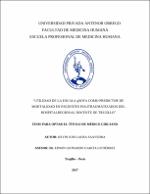Mostrar el registro sencillo del ítem
Utilidad de la escala qSOFA como predictor de mortalidad en pacientes politraumatizados del Hospital Regional Docente de Trujillo
| dc.contributor.advisor | García Gutierrez, Edwin Leonardo | |
| dc.contributor.author | Laura Saavedra, Kevin Juri | |
| dc.creator | Laura Saavedra, Kevin Juri | |
| dc.date.accessioned | 2018-04-06T15:55:18Z | |
| dc.date.available | 2018-04-06T15:55:18Z | |
| dc.date.issued | 2018 | |
| dc.identifier.uri | https://hdl.handle.net/20.500.12759/3895 | |
| dc.description.abstract | OBJETIVO: Determinar si la escala qSOFA tiene utilidad como predictor de mortalidad en pacientes politraumatizados del Hospital Regional Docente de Trujillo. MATERIAL Y MÉTODO: Estudio clínico observacional, analítico de corte transversal. Se incluyó 189 pacientes Politraumatizados atendidos en el Servicio de Trauma - Emergencia de Trauma del Hospital Regional Docente de Trujillo durante 3 años. Se registraron los datos generales de filiación, tiempo de enfermedad, hematocrito, lactato sérico, se registró la frecuencia respiratoria, presión arterial sistólica, puntaje en al escala de coma de Glasgow y se realizó el cálculo del score qSOFA; y la condición de alta del servicio. RESULTADOS: La escala qSOFA obtuvo una sensibilidad de 76%, una especificidad de 56%, un valor predictivo positivo de 50% y un valor predictivo negativo de 80%. Mostro un área bajo la curva ROC de 0.70 con mejor punto de corte un valor qSOFA ≥ 2. CONCLUSIONES: la escala qSOFA es de utilidad para predecir la mortalidad en pacientes politraumatizados. | es_PE |
| dc.description.abstract | OBJECTIVE: To determine if the qSOFA scale has utility as a predictor of mortality in polytraumatized patients of the Hospital Regional Docente de Trujillo. MATERIAL AND METHODS: An observational, cross-sectional, analytical study. We include a total of 189 polytraumatized patients attended at the Trauma Emergency Service of the Hospital Regional Docente de Trujillo for 3 years. The general data of affiliation, disease time, hematocrit, serum lactate, respiratory rate, systolic blood pressure and Glasgow coma scale were recorded, the calculation of the qSOFA score was performed; and the state of the discharged patient. RESULTS: qSOFA score had a sensitivity of 76%, a specificity of 56%, a PPV of 50% and a NPV of 80%. It also showed an area under ROC curve of 0.70 with best cutoff point of qSOFA ≥ 2. CONCLUSIONS: qSOFA score has utility in predicting the mortality of politraumatized patients. | en_US |
| dc.description.uri | Tesis | es_PE |
| dc.format | application/pdf | es_PE |
| dc.language.iso | spa | es_PE |
| dc.publisher | Universidad Privada Antenor Orrego - UPAO | es_PE |
| dc.relation.ispartofseries | T_MED.HUMA_2245 | |
| dc.rights | info:eu-repo/semantics/openAccess | es_PE |
| dc.source | Universidad Privada Antenor Orrego | es_PE |
| dc.source | Repositorio Institucional - UPAO | es_PE |
| dc.subject | qSOFA | es_PE |
| dc.subject | Politraumatizado | es_PE |
| dc.title | Utilidad de la escala qSOFA como predictor de mortalidad en pacientes politraumatizados del Hospital Regional Docente de Trujillo | es_PE |
| dc.type | info:eu-repo/semantics/bachelorThesis | es_PE |
| thesis.degree.level | Título Profesional | es_PE |
| thesis.degree.grantor | Universidad Privada Antenor Orrego. Facultad de Medicina Humana | es_PE |
| thesis.degree.name | Médico Cirujano | es_PE |
| thesis.degree.discipline | Medicina Humana | es_PE |
Ficheros en el ítem
Este ítem aparece en la(s) siguiente(s) colección(es)
-
Medicina Humana [2765]

